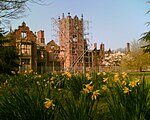Tarleton Academy
1973 establishments in EnglandAcademies in LancashireEducational institutions established in 1973Schools in the Borough of West LancashireSecondary schools in Lancashire ... and 1 more
Use British English from February 2023

Tarleton Academy is a secondary Academy situated in Tarleton, Lancashire, England; the head is Simon Day, appointed April 2021. The school caters for 11 to 16-year-olds. The academy is scheduled a complete building renewal to be completed in September 2023, with a total cost of 23 million pounds.
Excerpt from the Wikipedia article Tarleton Academy (License: CC BY-SA 3.0, Authors, Images).Tarleton Academy
Hesketh Lane, Preston Tarleton
Geographical coordinates (GPS) Address Phone number Website External links Nearby Places Show on map
Geographical coordinates (GPS)
| Latitude | Longitude |
|---|---|
| N 53.6854 ° | E -2.8301 ° |
Address
Tarleton Academy
Hesketh Lane
PR4 6AQ Preston, Tarleton
England, United Kingdom
Open on Google Maps







